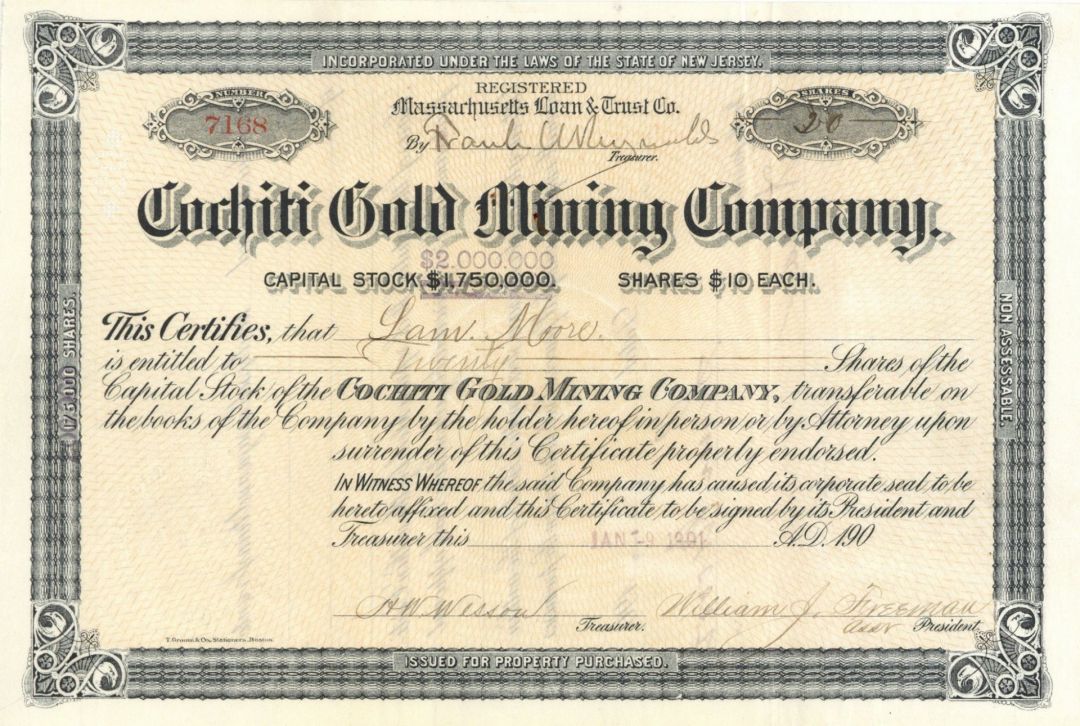Cochiti Gold Mining Co. - Stock Certificate
Inv# MS1381 StockNew Jersey
New Mexico
Stock printed by T. Groom & Co. Stationers, Boston. Located in Albemarle, New Mexico. Failed soon after.
Cochiti is a census-designated place (CDP) in Sandoval County, New Mexico, United States. A historic pueblo of the Cochiti people, it is part of the Albuquerque Metropolitan Statistical Area. The population was 528 at the 2010 census. Located 22 miles (35 km) southwest of Santa Fe, the community is listed as a historic district on the National Register of Historic Places.
The Cochiti pueblo people are a federally recognized tribe of Native Americans. According to the Keres Online Dictionary the Keresan-name for the People of Cochiti Pueblo is Kʾúutìimʾé ("People from the Mountains, i.e. Cochiti people").
The Cochiti speak Keres, an eastern Keresan language, which is a language isolate. In the early 21st century, the Keres Children's Learning Center, an independent Keres immersion school, was founded to aid with preservation of their language and culture. It has added grades since its founding.
The pueblo administers 53,779 acres (217.64 km2) of reservation land and works closely with the Bureau of Land Management who has jurisdiction over Kasha-Katuwe Tent Rocks National Monument.
The pueblo celebrates the annual feast day for its patron saint, San Buenaventura, on July 14.
The Cochiti people are thought to be descended from the Ancestral Puebloans (formerly known as the Anasazi). The ancestors of the Cochiti people, living in cliff dwellings at Rito de los Frijoles in present-day Bandelier National Monument, divided into two groups. One was located in the pueblo of Katishtya (later called San Felipe pueblo) in the south and the other was located in Potrero Viejo, one of the finger mesas of the Pajarito Plateau in northern central New Mexico. Approximately 12 miles northwest of the present-day Cochiti Pueblo, a temporary pueblo known as Hanut Cochiti had been established.
In 1598, Spanish conquistador, Juan de Oñate came to Cochiti Pueblo. At first, the Spaniards admired and respected the Pueblo Peoples for their Spanish-like farming techniques and villages, viewing them as equals, and opening trade. As time went on, the Spaniards attempted to assimilate Cochiti people (and other tribes) into New Spanish society. They were forced to pay taxes in crops, cotton, and work. The Spanish Catholic missionaries attacked their religion and renamed the Pueblos with Catholic saints’ names and began a program of church construction, such as the San Buenaventura Mission at Cochiti, routinely torturing the tribes for practicing their traditional religion, and forcing the them into labor and/or slavery.
The Cochiti pueblo people took part in the Pueblo Revolt of 1680, an uprising of the Native Americans against the Spaniards. When Spanish Governor Antonio de Otermin reconquered New Mexico, the tribe retreated with the other Keresan tribes of San Felipe and Santo Domingo (now called Kewa) to the Potrero Viejo.[ The Cochiti people remained at Potrero Viejo until 1693 when they were forced to flee Spanish Governor Don Diego de Vargas and his troops.
A stock certificate is issued by businesses, usually companies. A stock is part of the permanent finance of a business. Normally, they are never repaid, and the investor can recover his/her money only by selling to another investor. Most stocks, or also called shares, earn dividends, at the business's discretion, depending on how well it has traded. A stockholder or shareholder is a part-owner of the business that issued the stock certificates.











Ebay ID: labarre_galleries